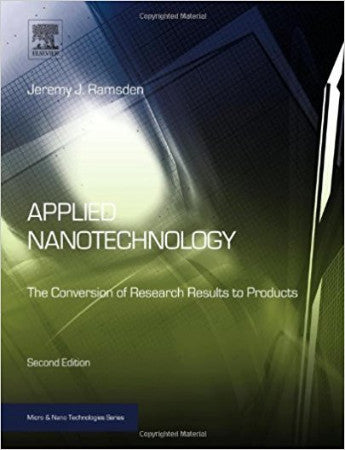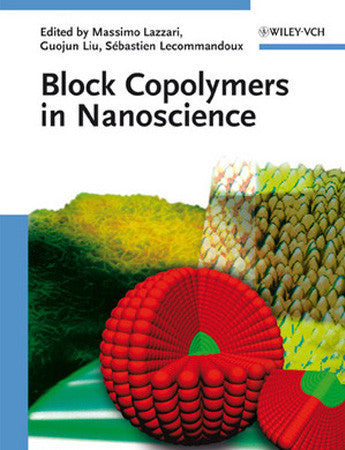Nanotechnology: Volume 1: Principles and Fundamentals
The ultimate reference book, providing an in-depth introduction to nanotechnology, discussing topics from ethics and philosophy to challenges faced by this up-and-coming industry, all in one comprehensive volume. The topic could not be hotter, Nanotechnology is the new technology drive of the 21st century paired with existing, multibillion dollar markets and fundings.
The 2 volumes set gives an excellent, in-depth overview of everything you need to know about nanotechnology and nanoscience with each volume dedicated to a specific topic which is covered in detail by experts from that particular field.
The 2 volumes set gives an excellent, in-depth overview of everything you need to know about nanotechnology and nanoscience with each volume dedicated to a specific topic which is covered in detail by experts from that particular field.
List of Contributors.
1. Introduction (Günter Schmid).
2. The Nature of Nanotechnology (Günter Schmid).
3. Top-Down Versus Bottom-Up (Wolfgang J. Parak, Friedrich C. Simmel, and Alexander W. Holleitner).
4. Fundamental Principles of Quantum Dots (Wolfgang J. Parak, Liberato manna, and Thomas Nann).
5. Fundamentals and Functionality of Inorganic Wires, Rods, and Tubes (Jörg J. Schneider, Alexander Popp, and Jörg Engstler).
6. Biomolecule-Nanoparticle Hybrid Systems (Maya Zayats and Itamar Willner).
7. Philosophy of Nanotechnoscience (Alfred Nordmann).
8. Ethics of Nanotechnology. State of the Art and Challenges Ahead (Armin Grunwald).
9. Outlook and Consequences (Günter Schmid).
References.
Index.
1. Introduction (Günter Schmid).
2. The Nature of Nanotechnology (Günter Schmid).
3. Top-Down Versus Bottom-Up (Wolfgang J. Parak, Friedrich C. Simmel, and Alexander W. Holleitner).
4. Fundamental Principles of Quantum Dots (Wolfgang J. Parak, Liberato manna, and Thomas Nann).
5. Fundamentals and Functionality of Inorganic Wires, Rods, and Tubes (Jörg J. Schneider, Alexander Popp, and Jörg Engstler).
6. Biomolecule-Nanoparticle Hybrid Systems (Maya Zayats and Itamar Willner).
7. Philosophy of Nanotechnoscience (Alfred Nordmann).
8. Ethics of Nanotechnology. State of the Art and Challenges Ahead (Armin Grunwald).
9. Outlook and Consequences (Günter Schmid).
References.
Index.
Gunter Schmid, Professor em. at the University of Duisburg-Essen. His research is focused on the interface between chemistry an physics, covering clusters, nanoparticles, and nanosciences. He published about 350 papers and edited several books on nanomaterials and nanotechnology. He acts as a member of several editorial boards, e.g. for Small and Advanced Functional Materials. In 2003 he received the prestigious Wilhelm-Klemm award of the German Chemical Society
Related Products
Applied Nanotechnology...
$155.00
{"id":11242226308,"title":"Applied Nanotechnology 2nd Ed","handle":"978-1455731893","description":"\u003ch5\u003eDescription\u003c\/h5\u003e\nAuthor: Jeremy Ramsden \u003cbr\u003eISBN 978-1455731893 \u003cbr\u003e\u003cbr\u003eHardbound, 240 Pages\n\u003ch5\u003eSummary\u003c\/h5\u003e\nAn overview of nanotechnology that encompasses scientific, technological, economic and social issues – investigating the potential of nanotechnology to transform whole sectors of industry from healthcare to energy. Jeremy Ramsden provides a blueprint for those involved in the commercialization of nanotechnology. \u003cbr\u003e\u003cbr\u003eIn \u003cb\u003eApplied Nanotechnology\u003c\/b\u003e Professor Ramsden takes an integrated approach to the scientific, commercial and social aspects of nanotechnology, exploring:\u003cbr\u003e\u003cbr\u003e\n\u003cul\u003e\n\u003cli\u003eThe relationship between nanotechnology and innovation\u003c\/li\u003e\n\u003cli\u003eThe changing economics and business models required to commercialize innovations in nanotechnology\u003c\/li\u003e\n\u003cli\u003eProduct design challenges - investigated through case studies\u003c\/li\u003e\n\u003cli\u003eApplications in various sectors, including composite materials, energy, and agriculture\u003c\/li\u003e\n\u003cli\u003eThe role of government in promoting nanotechnology\u003c\/li\u003e\n\u003cli\u003eThe potential future of molecular self-assembly in industrial production\u003c\/li\u003e\n\u003cli\u003eThe ethics and social implications of nanotechnology\u003cbr\u003e\u003cbr\u003e\u003cbr\u003eAs well as providing business models and practical examples of the innovation process, this book offers a vision of the role of nanotechnology in confronting the challenges facing humanity, from healthcare to climate change.\u003cbr\u003e\u003cbr\u003e\n\u003c\/li\u003e\n\u003c\/ul\u003e\n\u003ch5\u003eTable of Contents\u003c\/h5\u003e\nPart I Technology Basics\u003cbr\u003e\u003cbr\u003e1. What is nanotechnology?\u003cbr\u003e\u003cbr\u003e2. Science, technology, and wealth\u003cbr\u003e\u003cbr\u003e3. Innovation\u003cbr\u003e\u003cbr\u003e4. Why nanotechnology?\u003cbr\u003e\u003cbr\u003ePart II Nanotechnology Products\u003cbr\u003e\u003cbr\u003e5. The nanotechnology business\u003cbr\u003e\u003cbr\u003e6. Miscellaneous applications\u003cbr\u003e\u003cbr\u003e7. Information technologies\u003cbr\u003e\u003cbr\u003e8. Applications to health\u003cbr\u003e\u003cbr\u003ePart III Organizing Nanotechnology Business\u003cbr\u003e\u003cbr\u003e9. The business environment\u003cbr\u003e\u003cbr\u003e10. Assessing demand for nanotechnology\u003cbr\u003e\u003cbr\u003e11. Design of nanotechnology products\u003cbr\u003e\u003cbr\u003ePart IV Wide and Long-Term Issues\u003cbr\u003e\u003cbr\u003e12. The future of nanotechnology\u003cbr\u003e\u003cbr\u003e13. Grand challenges\u003cbr\u003e\u003cbr\u003e14. Ethics and nanotechnology\u003cbr\u003e\u003cbr\u003e\n\u003ch5\u003eAbout Author\u003c\/h5\u003e\nProfessor Jeremy Ramsden graduated (Natural Sciences) from Cambridge University and obtained his doctorate from the Ecole Polytechnique Federale in Lausanne. He was appointed as Professor of Nanotechnology at Cranfield University in 2002, becoming additionally Director of Research for Bionanotechnology at Cranfield University?s Kitakyushu campus in 2003.","published_at":"2017-06-22T21:14:01-04:00","created_at":"2017-06-22T21:14:01-04:00","vendor":"Chemtec Publishing","type":"Book","tags":["2013","appilcation","biotechnology","book","MEMS","micro- and nanotechnology","nano"],"price":15500,"price_min":15500,"price_max":15500,"available":true,"price_varies":false,"compare_at_price":null,"compare_at_price_min":0,"compare_at_price_max":0,"compare_at_price_varies":false,"variants":[{"id":43378391940,"title":"Default Title","option1":"Default Title","option2":null,"option3":null,"sku":"","requires_shipping":true,"taxable":true,"featured_image":null,"available":true,"name":"Applied Nanotechnology 2nd Ed","public_title":null,"options":["Default Title"],"price":15500,"weight":1000,"compare_at_price":null,"inventory_quantity":1,"inventory_management":null,"inventory_policy":"continue","barcode":"978-1455731893","requires_selling_plan":false,"selling_plan_allocations":[]}],"images":["\/\/chemtec.org\/cdn\/shop\/products\/978-1455731893.jpg?v=1498190869"],"featured_image":"\/\/chemtec.org\/cdn\/shop\/products\/978-1455731893.jpg?v=1498190869","options":["Title"],"media":[{"alt":null,"id":350156292189,"position":1,"preview_image":{"aspect_ratio":0.767,"height":450,"width":345,"src":"\/\/chemtec.org\/cdn\/shop\/products\/978-1455731893.jpg?v=1498190869"},"aspect_ratio":0.767,"height":450,"media_type":"image","src":"\/\/chemtec.org\/cdn\/shop\/products\/978-1455731893.jpg?v=1498190869","width":345}],"requires_selling_plan":false,"selling_plan_groups":[],"content":"\u003ch5\u003eDescription\u003c\/h5\u003e\nAuthor: Jeremy Ramsden \u003cbr\u003eISBN 978-1455731893 \u003cbr\u003e\u003cbr\u003eHardbound, 240 Pages\n\u003ch5\u003eSummary\u003c\/h5\u003e\nAn overview of nanotechnology that encompasses scientific, technological, economic and social issues – investigating the potential of nanotechnology to transform whole sectors of industry from healthcare to energy. Jeremy Ramsden provides a blueprint for those involved in the commercialization of nanotechnology. \u003cbr\u003e\u003cbr\u003eIn \u003cb\u003eApplied Nanotechnology\u003c\/b\u003e Professor Ramsden takes an integrated approach to the scientific, commercial and social aspects of nanotechnology, exploring:\u003cbr\u003e\u003cbr\u003e\n\u003cul\u003e\n\u003cli\u003eThe relationship between nanotechnology and innovation\u003c\/li\u003e\n\u003cli\u003eThe changing economics and business models required to commercialize innovations in nanotechnology\u003c\/li\u003e\n\u003cli\u003eProduct design challenges - investigated through case studies\u003c\/li\u003e\n\u003cli\u003eApplications in various sectors, including composite materials, energy, and agriculture\u003c\/li\u003e\n\u003cli\u003eThe role of government in promoting nanotechnology\u003c\/li\u003e\n\u003cli\u003eThe potential future of molecular self-assembly in industrial production\u003c\/li\u003e\n\u003cli\u003eThe ethics and social implications of nanotechnology\u003cbr\u003e\u003cbr\u003e\u003cbr\u003eAs well as providing business models and practical examples of the innovation process, this book offers a vision of the role of nanotechnology in confronting the challenges facing humanity, from healthcare to climate change.\u003cbr\u003e\u003cbr\u003e\n\u003c\/li\u003e\n\u003c\/ul\u003e\n\u003ch5\u003eTable of Contents\u003c\/h5\u003e\nPart I Technology Basics\u003cbr\u003e\u003cbr\u003e1. What is nanotechnology?\u003cbr\u003e\u003cbr\u003e2. Science, technology, and wealth\u003cbr\u003e\u003cbr\u003e3. Innovation\u003cbr\u003e\u003cbr\u003e4. Why nanotechnology?\u003cbr\u003e\u003cbr\u003ePart II Nanotechnology Products\u003cbr\u003e\u003cbr\u003e5. The nanotechnology business\u003cbr\u003e\u003cbr\u003e6. Miscellaneous applications\u003cbr\u003e\u003cbr\u003e7. Information technologies\u003cbr\u003e\u003cbr\u003e8. Applications to health\u003cbr\u003e\u003cbr\u003ePart III Organizing Nanotechnology Business\u003cbr\u003e\u003cbr\u003e9. The business environment\u003cbr\u003e\u003cbr\u003e10. Assessing demand for nanotechnology\u003cbr\u003e\u003cbr\u003e11. Design of nanotechnology products\u003cbr\u003e\u003cbr\u003ePart IV Wide and Long-Term Issues\u003cbr\u003e\u003cbr\u003e12. The future of nanotechnology\u003cbr\u003e\u003cbr\u003e13. Grand challenges\u003cbr\u003e\u003cbr\u003e14. Ethics and nanotechnology\u003cbr\u003e\u003cbr\u003e\n\u003ch5\u003eAbout Author\u003c\/h5\u003e\nProfessor Jeremy Ramsden graduated (Natural Sciences) from Cambridge University and obtained his doctorate from the Ecole Polytechnique Federale in Lausanne. He was appointed as Professor of Nanotechnology at Cranfield University in 2002, becoming additionally Director of Research for Bionanotechnology at Cranfield University?s Kitakyushu campus in 2003."}
Block Copolymers in Na...
$261.00
{"id":11242200964,"title":"Block Copolymers in Nanoscience","handle":"978-3-527-31309-9","description":"\u003ch5\u003eDescription\u003c\/h5\u003e\nAuthor: Eds., M. Lazzari, Guojun Liu, S. Lecommandoux \u003cbr\u003eISBN \u003cspan\u003e978-3-527-61056-3\u003c\/span\u003e \u003cbr\u003e\u003cbr\u003epages 447, Hardcover\n\u003ch5\u003eSummary\u003c\/h5\u003e\nThe book investigates all types of application for block copolymers: as tools for fabricating other nanomaterials, as structural components in hybrid materials and nanocomposites, and as functional materials. The multidisciplinary approach covers all stages from chemical synthesis and characterization, presenting applications from physics and chemistry to biology and medicine, such as micro- and nanolithography, membranes, optical labeling, drug delivery, as well as sensory and analytical uses.\n\u003ch5\u003eTable of Contents\u003c\/h5\u003e\nAn Introduction to Block Copolymer Applications: State-of-the-art and Future Developments. \u003cbr\u003e\u003cbr\u003e2. Guidelines for Synthesizing Block Copolymers. \u003cbr\u003e\u003cbr\u003e3. Block Copolymer Vesicles. \u003cbr\u003e\u003cbr\u003e4. Block Copolymer Micelles for Drug Delivery in Nanoscience. \u003cbr\u003e\u003cbr\u003e5. Stimuli-responsive Block Copolymer Assemblies. \u003cbr\u003e\u003cbr\u003e6. Self-assembly of Linear Polypeptide-based Block Copolymers. \u003cbr\u003e\u003cbr\u003e7. Synthesis, Self-assembly and Applications of Polyferrocenylsilane (PFS) Block Copolymers. \u003cbr\u003e\u003cbr\u003e8. Supramolecular Block Polymers Containing Metal-Ligand Binding Sites: From Synthesis to Properties. \u003cbr\u003e\u003cbr\u003e9. Methods for the Alignment and the Large-scale Ordering of Block Copolymer Morphologies. \u003cbr\u003e\u003cbr\u003e10. Block Copolymer Nanofibers and Nanotubes. \u003cbr\u003e\u003cbr\u003e11. Nanostructured Carbons from Block Coplymers. \u003cbr\u003e\u003cbr\u003e12. Block Copolymers at Interfaces. \u003cbr\u003e\u003cbr\u003e13. Block Copolymers as Templates for the Generation of Mesostructured Inorganic Materials. \u003cbr\u003e\u003cbr\u003e14. Mesostructured Polymers-Inorganic Hybrid Materials from Blocked Macromolecular Architectures and Nanoparticles. \u003cbr\u003e\u003cbr\u003e15. Block Ionomers for Fuel Cell Application. \u003cbr\u003e\u003cbr\u003e16. Structure, Properties and Applications of Crystallizable ABA and ABC Triblock Copolymers with Hydrogenated Polybutadiene Blocks. \u003cbr\u003e\u003cbr\u003e17. Basic Understanding of Phase Behavior and Structure of Silicone Block Copolymers and Surfactant-Block Copolymer Mixtures. \u003cbr\u003e\u003cbr\u003eSubject Index.\u003cbr\u003e\u003cbr\u003e\n\u003ch5\u003eAbout Author\u003c\/h5\u003e\n\u003cb\u003eMassimo Lazzari\u003c\/b\u003e received his PhD in Macromolecular Chemistry at the University of Torino (Italy) under the supervision of Prof. O. Chiantore. After a two years postdoctoral work with Prof. K. Hatada at the Osaka University (Japan), where he learned the secrets of anionic polymerisation, in 1998 he became the assistant professor at the University of Torino, working on the characterisation and degradation of complex polymer systems. After several stays at the University of Santiago de Compostela (Spain), he is actually in the Institute of Technological Investigations. His current research interests are focused on the synthesis of self-assembling block copolymers, with a special attention on their use as templates and for the hierarchical self-assembly of metal nanoparticles. Guojun Liu received his PhD. degree from the University of Toronto in 1989. After 8 months as a post-doctoral fellow in the University of Toronto, he joined McGill University for another post-doctoral year. He was appointed assistant professor at the University of Calgary in 1990, promoted to associate professor in 1995 and full professor in 1999. Since 2004 he has been serving the Department of Chemistry at Queen's University as Tier I (senior) Canada Research Chair in Materials Science. He has published more than 100 papers mostly on block copolymer nanomaterials. Physico-chemist of formation, Sebasstien Lecommandoux has integrated the Centre de Recherche Paul Pascal (group of Professor Franz Hardouin, Bordeaux, France) in 1992 to prepare his Master and his Diploma Thesis in Chemistry and Physics (1996) on Liquid Crystal Polymers. Then, he went to the Material Research Laboratory and the Beckman Institute (University of Illinois at Urbana-Champaign, USA), as a Post-Doc in the group of Professor Samuel I. Stupp, and learned the Art of Supramolecular Chemistry from January to December 1998. He joined the Laboratoire de Chimie des Polymeres Organiques (CNRS, University of Bordeaux, France) as Associate Professor in 1998 and became Professor in 2005. He received the Bronze Medal Award from the CNRS in 2004 for the work he did on the self-assembly of polypeptide-based block copolymers. His current research interests mainly focus on macromolecular engineering via block copolymer self-assembly in solution and in bulk, with a special attention on the relationship between nanostructures and biological functions.","published_at":"2017-06-22T21:12:40-04:00","created_at":"2017-06-22T21:12:40-04:00","vendor":"Chemtec Publishing","type":"Book","tags":["2007","ABA","ABC","block copolymer","book","membranes","mesostructured","nano","nanofibers","nanolithography","nanotubes. nanostructured carbons interfaces","polybutadiene","polymers","silicone","templates","triblock"],"price":26100,"price_min":26100,"price_max":26100,"available":true,"price_varies":false,"compare_at_price":null,"compare_at_price_min":0,"compare_at_price_max":0,"compare_at_price_varies":false,"variants":[{"id":43378308036,"title":"Default Title","option1":"Default Title","option2":null,"option3":null,"sku":"","requires_shipping":true,"taxable":true,"featured_image":null,"available":true,"name":"Block Copolymers in Nanoscience","public_title":null,"options":["Default Title"],"price":26100,"weight":1000,"compare_at_price":null,"inventory_quantity":1,"inventory_management":null,"inventory_policy":"continue","barcode":"978-3-527-61056-3","requires_selling_plan":false,"selling_plan_allocations":[]}],"images":["\/\/chemtec.org\/cdn\/shop\/products\/978-3-527-31309-9.jpg?v=1499189503"],"featured_image":"\/\/chemtec.org\/cdn\/shop\/products\/978-3-527-31309-9.jpg?v=1499189503","options":["Title"],"media":[{"alt":null,"id":353915371613,"position":1,"preview_image":{"aspect_ratio":0.767,"height":450,"width":345,"src":"\/\/chemtec.org\/cdn\/shop\/products\/978-3-527-31309-9.jpg?v=1499189503"},"aspect_ratio":0.767,"height":450,"media_type":"image","src":"\/\/chemtec.org\/cdn\/shop\/products\/978-3-527-31309-9.jpg?v=1499189503","width":345}],"requires_selling_plan":false,"selling_plan_groups":[],"content":"\u003ch5\u003eDescription\u003c\/h5\u003e\nAuthor: Eds., M. Lazzari, Guojun Liu, S. Lecommandoux \u003cbr\u003eISBN \u003cspan\u003e978-3-527-61056-3\u003c\/span\u003e \u003cbr\u003e\u003cbr\u003epages 447, Hardcover\n\u003ch5\u003eSummary\u003c\/h5\u003e\nThe book investigates all types of application for block copolymers: as tools for fabricating other nanomaterials, as structural components in hybrid materials and nanocomposites, and as functional materials. The multidisciplinary approach covers all stages from chemical synthesis and characterization, presenting applications from physics and chemistry to biology and medicine, such as micro- and nanolithography, membranes, optical labeling, drug delivery, as well as sensory and analytical uses.\n\u003ch5\u003eTable of Contents\u003c\/h5\u003e\nAn Introduction to Block Copolymer Applications: State-of-the-art and Future Developments. \u003cbr\u003e\u003cbr\u003e2. Guidelines for Synthesizing Block Copolymers. \u003cbr\u003e\u003cbr\u003e3. Block Copolymer Vesicles. \u003cbr\u003e\u003cbr\u003e4. Block Copolymer Micelles for Drug Delivery in Nanoscience. \u003cbr\u003e\u003cbr\u003e5. Stimuli-responsive Block Copolymer Assemblies. \u003cbr\u003e\u003cbr\u003e6. Self-assembly of Linear Polypeptide-based Block Copolymers. \u003cbr\u003e\u003cbr\u003e7. Synthesis, Self-assembly and Applications of Polyferrocenylsilane (PFS) Block Copolymers. \u003cbr\u003e\u003cbr\u003e8. Supramolecular Block Polymers Containing Metal-Ligand Binding Sites: From Synthesis to Properties. \u003cbr\u003e\u003cbr\u003e9. Methods for the Alignment and the Large-scale Ordering of Block Copolymer Morphologies. \u003cbr\u003e\u003cbr\u003e10. Block Copolymer Nanofibers and Nanotubes. \u003cbr\u003e\u003cbr\u003e11. Nanostructured Carbons from Block Coplymers. \u003cbr\u003e\u003cbr\u003e12. Block Copolymers at Interfaces. \u003cbr\u003e\u003cbr\u003e13. Block Copolymers as Templates for the Generation of Mesostructured Inorganic Materials. \u003cbr\u003e\u003cbr\u003e14. Mesostructured Polymers-Inorganic Hybrid Materials from Blocked Macromolecular Architectures and Nanoparticles. \u003cbr\u003e\u003cbr\u003e15. Block Ionomers for Fuel Cell Application. \u003cbr\u003e\u003cbr\u003e16. Structure, Properties and Applications of Crystallizable ABA and ABC Triblock Copolymers with Hydrogenated Polybutadiene Blocks. \u003cbr\u003e\u003cbr\u003e17. Basic Understanding of Phase Behavior and Structure of Silicone Block Copolymers and Surfactant-Block Copolymer Mixtures. \u003cbr\u003e\u003cbr\u003eSubject Index.\u003cbr\u003e\u003cbr\u003e\n\u003ch5\u003eAbout Author\u003c\/h5\u003e\n\u003cb\u003eMassimo Lazzari\u003c\/b\u003e received his PhD in Macromolecular Chemistry at the University of Torino (Italy) under the supervision of Prof. O. Chiantore. After a two years postdoctoral work with Prof. K. Hatada at the Osaka University (Japan), where he learned the secrets of anionic polymerisation, in 1998 he became the assistant professor at the University of Torino, working on the characterisation and degradation of complex polymer systems. After several stays at the University of Santiago de Compostela (Spain), he is actually in the Institute of Technological Investigations. His current research interests are focused on the synthesis of self-assembling block copolymers, with a special attention on their use as templates and for the hierarchical self-assembly of metal nanoparticles. Guojun Liu received his PhD. degree from the University of Toronto in 1989. After 8 months as a post-doctoral fellow in the University of Toronto, he joined McGill University for another post-doctoral year. He was appointed assistant professor at the University of Calgary in 1990, promoted to associate professor in 1995 and full professor in 1999. Since 2004 he has been serving the Department of Chemistry at Queen's University as Tier I (senior) Canada Research Chair in Materials Science. He has published more than 100 papers mostly on block copolymer nanomaterials. Physico-chemist of formation, Sebasstien Lecommandoux has integrated the Centre de Recherche Paul Pascal (group of Professor Franz Hardouin, Bordeaux, France) in 1992 to prepare his Master and his Diploma Thesis in Chemistry and Physics (1996) on Liquid Crystal Polymers. Then, he went to the Material Research Laboratory and the Beckman Institute (University of Illinois at Urbana-Champaign, USA), as a Post-Doc in the group of Professor Samuel I. Stupp, and learned the Art of Supramolecular Chemistry from January to December 1998. He joined the Laboratoire de Chimie des Polymeres Organiques (CNRS, University of Bordeaux, France) as Associate Professor in 1998 and became Professor in 2005. He received the Bronze Medal Award from the CNRS in 2004 for the work he did on the self-assembly of polypeptide-based block copolymers. His current research interests mainly focus on macromolecular engineering via block copolymer self-assembly in solution and in bulk, with a special attention on the relationship between nanostructures and biological functions."}
Carbon Nanotubes for B...
$159.00
{"id":11242233924,"title":"Carbon Nanotubes for Biomedical Applications","handle":"978-3-642-14801-9","description":"\u003ch5\u003eDescription\u003c\/h5\u003e\nAuthor: Klingeler, Rüdiger; Sim, Robert B. (Eds.) \u003cbr\u003eISBN 978-3-642-14801-9 \u003cbr\u003e\u003cbr\u003e1st Edition., 2011, XX, 280 p. 38 illus. in color., Hardcover\n\u003ch5\u003eSummary\u003c\/h5\u003e\nThis book explores the potential of multi-functional carbon nanotubes for biomedical applications. It combines contributions from chemistry, physics, biology, engineering, and medicine. The complete overview of the state-of-the-art addresses different synthesis and biofunctionalisation routes and shows the structural and magnetic properties of nanotubes relevant to biomedical applications. Particular emphasis is put on the interaction of carbon nanotubes with biological environments, i.e. toxicity, biocompatibility, cellular uptake, intracellular distribution, interaction with the immune system and environmental impact. The insertion of NMR-active substances allows diagnostic usage as markers and sensors, e.g. for imaging and contactless local temperature sensing. The potential of nanotubes for therapeutic applications is highlighted by studies on chemotherapeutic drug filling and release, targeting and magnetic hyperthermia studies for anti-cancer treatment at the cellular level.\n\u003ch5\u003eTable of Contents\u003c\/h5\u003e\n\u003cp\u003ePart I Fundamental: Synthesis of Multifunctional Nanomaterials and their Potential for Medical Application\u003c\/p\u003e\n\u003cp\u003e1. Physical Properties of Carbon Nanotubes for Therapeutic Application\u003c\/p\u003e\n\u003cp\u003e2. Carbon Nanotubes in Regenerative Medicine\u003c\/p\u003e\n\u003cp\u003e3. Filling of Carbon Nanotubes with Compounds in Solution or Melted Phase\u003c\/p\u003e\n\u003cp\u003e4. Filling of Carbon Nanotubes: Containers for Magnetic Probes and Drug Delivery\u003c\/p\u003e\n\u003cp\u003ePart II Magnetically Functionalised Carbon Nanotubes for Medical Diagnosis and Therapy\u003c\/p\u003e\n\u003cp\u003e5. Magnetic Nanoparticles for Diagnosis and Medical Therapy\u003c\/p\u003e\n\u003cp\u003e6. Feasibility of Magnetically Functionalised Carbon Nanotubes for Biological Applications: From Fundamental Properties of Individual Nanomagnets to Nanoscaled Heaters and Temperature Sensors\u003c\/p\u003e\n\u003cp\u003e6. Nuclear Magnetic Resonance Spectroscopy and Imaging of Carbon Nanotubes\u003c\/p\u003e\n\u003cp\u003ePart III Interaction with Biological Systems\u003c\/p\u003e\n\u003cp\u003e7. Exploring Carbon Nanotubes and Their Interaction with Cells Using Atomic Force Microscopy\u003c\/p\u003e\n\u003cp\u003e8. Uptake, Intracellular Localization and Biodistribution of Carbon Nanotubes\u003c\/p\u003e\n\u003cp\u003e9. Recognition of Carbon Nanotubes by Human Innate Immune System\u003c\/p\u003e\n\u003cp\u003e10. Toxicity and Environmental Impact of Carbon Nanotubes \u003c\/p\u003e\n\u003cp\u003ePart IV Towards Targeted Chemotherapy and Gene Delivery\u003c\/p\u003e\n\u003cp\u003e11. Carbon Nanotubes Loaded with Anticancer Drugs: A Platform for Multimodal Cancer Treatment\u003c\/p\u003e\n\u003cp\u003e12. Carbon Nanotubes Filled with Carboplatin: Towards Supported Delivery of Chemotherapeutic Agents\u003c\/p\u003e\n\u003cp\u003e13. Functionalized Carbon Nanotubes for Gene Biodeloivery \u003c\/p\u003e\n\u003cp\u003e \u003c\/p\u003e\n\u003cp\u003e \u003c\/p\u003e\n\u003cp\u003e \u003c\/p\u003e","published_at":"2017-06-22T21:14:24-04:00","created_at":"2017-06-22T21:14:24-04:00","vendor":"Chemtec Publishing","type":"Book","tags":["2011","biocompatibility","biomedical application","book","cellular uptake","intracellular distribution","nano","nantubes","NMR-active substances","toxicity"],"price":15900,"price_min":15900,"price_max":15900,"available":true,"price_varies":false,"compare_at_price":null,"compare_at_price_min":0,"compare_at_price_max":0,"compare_at_price_varies":false,"variants":[{"id":43378414596,"title":"Default Title","option1":"Default Title","option2":null,"option3":null,"sku":"","requires_shipping":true,"taxable":true,"featured_image":null,"available":true,"name":"Carbon Nanotubes for Biomedical Applications","public_title":null,"options":["Default Title"],"price":15900,"weight":1000,"compare_at_price":null,"inventory_quantity":1,"inventory_management":null,"inventory_policy":"continue","barcode":"978-3-642-14801-9","requires_selling_plan":false,"selling_plan_allocations":[]}],"images":["\/\/chemtec.org\/cdn\/shop\/products\/978-3-642-14801-9.jpg?v=1499723975"],"featured_image":"\/\/chemtec.org\/cdn\/shop\/products\/978-3-642-14801-9.jpg?v=1499723975","options":["Title"],"media":[{"alt":null,"id":353925562461,"position":1,"preview_image":{"aspect_ratio":0.767,"height":450,"width":345,"src":"\/\/chemtec.org\/cdn\/shop\/products\/978-3-642-14801-9.jpg?v=1499723975"},"aspect_ratio":0.767,"height":450,"media_type":"image","src":"\/\/chemtec.org\/cdn\/shop\/products\/978-3-642-14801-9.jpg?v=1499723975","width":345}],"requires_selling_plan":false,"selling_plan_groups":[],"content":"\u003ch5\u003eDescription\u003c\/h5\u003e\nAuthor: Klingeler, Rüdiger; Sim, Robert B. (Eds.) \u003cbr\u003eISBN 978-3-642-14801-9 \u003cbr\u003e\u003cbr\u003e1st Edition., 2011, XX, 280 p. 38 illus. in color., Hardcover\n\u003ch5\u003eSummary\u003c\/h5\u003e\nThis book explores the potential of multi-functional carbon nanotubes for biomedical applications. It combines contributions from chemistry, physics, biology, engineering, and medicine. The complete overview of the state-of-the-art addresses different synthesis and biofunctionalisation routes and shows the structural and magnetic properties of nanotubes relevant to biomedical applications. Particular emphasis is put on the interaction of carbon nanotubes with biological environments, i.e. toxicity, biocompatibility, cellular uptake, intracellular distribution, interaction with the immune system and environmental impact. The insertion of NMR-active substances allows diagnostic usage as markers and sensors, e.g. for imaging and contactless local temperature sensing. The potential of nanotubes for therapeutic applications is highlighted by studies on chemotherapeutic drug filling and release, targeting and magnetic hyperthermia studies for anti-cancer treatment at the cellular level.\n\u003ch5\u003eTable of Contents\u003c\/h5\u003e\n\u003cp\u003ePart I Fundamental: Synthesis of Multifunctional Nanomaterials and their Potential for Medical Application\u003c\/p\u003e\n\u003cp\u003e1. Physical Properties of Carbon Nanotubes for Therapeutic Application\u003c\/p\u003e\n\u003cp\u003e2. Carbon Nanotubes in Regenerative Medicine\u003c\/p\u003e\n\u003cp\u003e3. Filling of Carbon Nanotubes with Compounds in Solution or Melted Phase\u003c\/p\u003e\n\u003cp\u003e4. Filling of Carbon Nanotubes: Containers for Magnetic Probes and Drug Delivery\u003c\/p\u003e\n\u003cp\u003ePart II Magnetically Functionalised Carbon Nanotubes for Medical Diagnosis and Therapy\u003c\/p\u003e\n\u003cp\u003e5. Magnetic Nanoparticles for Diagnosis and Medical Therapy\u003c\/p\u003e\n\u003cp\u003e6. Feasibility of Magnetically Functionalised Carbon Nanotubes for Biological Applications: From Fundamental Properties of Individual Nanomagnets to Nanoscaled Heaters and Temperature Sensors\u003c\/p\u003e\n\u003cp\u003e6. Nuclear Magnetic Resonance Spectroscopy and Imaging of Carbon Nanotubes\u003c\/p\u003e\n\u003cp\u003ePart III Interaction with Biological Systems\u003c\/p\u003e\n\u003cp\u003e7. Exploring Carbon Nanotubes and Their Interaction with Cells Using Atomic Force Microscopy\u003c\/p\u003e\n\u003cp\u003e8. Uptake, Intracellular Localization and Biodistribution of Carbon Nanotubes\u003c\/p\u003e\n\u003cp\u003e9. Recognition of Carbon Nanotubes by Human Innate Immune System\u003c\/p\u003e\n\u003cp\u003e10. Toxicity and Environmental Impact of Carbon Nanotubes \u003c\/p\u003e\n\u003cp\u003ePart IV Towards Targeted Chemotherapy and Gene Delivery\u003c\/p\u003e\n\u003cp\u003e11. Carbon Nanotubes Loaded with Anticancer Drugs: A Platform for Multimodal Cancer Treatment\u003c\/p\u003e\n\u003cp\u003e12. Carbon Nanotubes Filled with Carboplatin: Towards Supported Delivery of Chemotherapeutic Agents\u003c\/p\u003e\n\u003cp\u003e13. Functionalized Carbon Nanotubes for Gene Biodeloivery \u003c\/p\u003e\n\u003cp\u003e \u003c\/p\u003e\n\u003cp\u003e \u003c\/p\u003e\n\u003cp\u003e \u003c\/p\u003e"}




